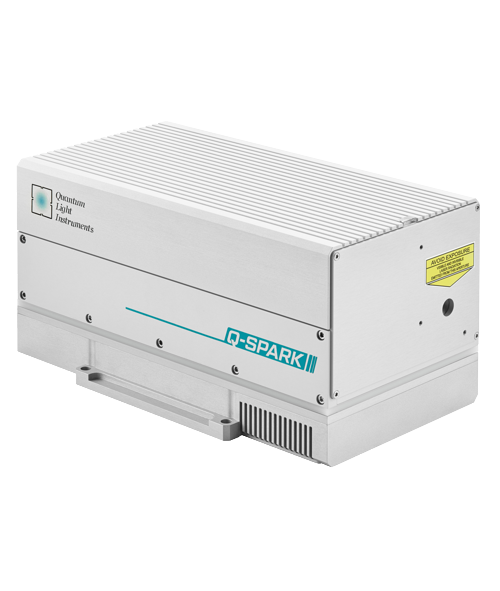Description
Q-SPARK is diode pumped, water-free, Q-switched laser designed for wide range of applications that require sub-nanosecond or nanosecond pulses with up to 20 MW peak power.
We optimized our innovative water-free laser crystal end-pumping technology to produce Gaussian-like, low divergence, sub-nanosecond pulses in compact and energy-efficient package.
Passively Q-switched Q-SPARK version can be configured to produce pulses as short as 750 ps and with more than 5 mJ pulse energy. E-O Q-switched version delivers up to 20 mJ with Laser is monitored and controlled trough Ethernet port via build-in web-server. API is also provided for integration with user devices.
Laser functionality can be further extended by wide selection of auxiliary equipment:
• Up to fourth harmonic output wavelength can be produced build-in harmonics generator, located inside laser body. See datasheet below for pulse energy specifications.
• Pulse energy can be adjusted with our attachable motorized attenuator for fundamental or harmonic wavelength beam.
• Pulse energy can be monitored by our attachable pulse energy monitor with analog and/or digital output.
• Residual harmonic generator wavelengths can be accessed with optional auxiliary exit port.
• Fiber coupled output is available by request. Please inquire for detailed specifications.
Applications
- Laser Induced Breakdown Spectroscopy (LIBS)
- Light Detection And Ranging (LIDAR)
- Laser ablation/micromachining
- Time-of-Flight Spectroscopy (TOFS)
- Time Resolved Spectroscopy (TRS)
- Time domain thermoreflectance (TDTR)
Specifications 1)
| Model |
Q-SPARK- |
||||||
|
100PS |
20PS |
A10PS |
A100 |
A50 |
B20 |
C10 |
|
| Wavelength, nm |
1064 nm |
||||||
| Q-Switch type |
Passive, Cr:YAG |
Active, Pockels cell |
|||||
|
Pulse repetition rate2) |
100 Hz |
20 Hz |
10Hz |
100 Hz |
50 Hz |
20 Hz |
10 Hz |
| Pulse energy, mJ |
1 mJ |
2 mJ |
5 mJ |
2 mJ |
5 mJ |
10 mJ |
20 mJ |
| Typical pulse duration 3) |
< 2 ns |
<800 ps |
<2 ns |
<1.5 ns |
|||
| Pulse to pulse energy stability 4) |
< 1.5 % RMS |
< 1.2 % RMS |
|||||
| Linewidth |
SLM5) |
<0.8 cm-1 |
|||||
| Power drift 6) |
± 3.0 % |
||||||
|
Beam profile |
nearly TEM00, >85 % fit to Gaussian |
||||||
| Beam divergence7) |
< 1.5 mrad |
<1 mrad |
|||||
| Polarization |
Linear, horizontal |
||||||
| Typical beam diameter 8) |
1.2 mm |
2.0 mm |
|||||
| Jitter 9) |
1 µs RMS |
< 0.5 ns RMS |
|||||
| Optional build-in harmonics generator 10) | |||||||
| Pulse energy | |||||||
| 532 nm |
0.5 mJ |
1 mJ |
2.5 mJ |
1 mJ |
2.5 mJ |
5 mJ |
10 mJ |
| 355 nm |
0.25 mJ |
0.5 mJ |
1.6 mJ |
0.5 mJ |
1.6 mJ |
2.5 mJ |
5 mJ |
| 266 nm |
0.1 mJ |
0.2 mJ |
0.8 mJ |
0.2 mJ |
0.8 mJ |
1.5 mJ |
2.5 mJ |
| Optional attenuator 11) | |||||||
|
Transmission range |
0.5 – 95 % |
||||||
| Dimensions | |||||||
| Laser head ( W×L×H) |
140× 277× 135 mm3 |
||||||
| Controller unit (W×L×H) |
108× 191 × 59 mm3 |
||||||
| Power adapter (W×L×H) 12) |
50 × 125 × 32 mm3 typical (for +12 VDC output) |
||||||
| Operating requirements | |||||||
|
Cooling requirements |
Air cooled |
||||||
| Ambient temperature |
15 – 30 ºC |
||||||
| Relative humidity |
10 – 80 % (non-condensing) |
||||||
| Mains voltage |
90-230 VAC, single phase, 47-63 Hz 13) |
||||||
| Average power consumption |
40 W |
30 W |
50 W |
40 W |
30W |
||
1. Due to continuous improvements all specifications are subject to change. Unless stated otherwise all specifications are measured at fundamental wavelength and maximum pulse repetition rate. The parameters marked typical are not specifications. They are indications of typical performance and will vary with each unit we manufacture.
2. Factory-set pulse repetition rate is fixed at max repetition rate shown in the table.
3. At FWHM level at fundamental wavelength, measured with 350 ps rise time photodiode.
4. Measured during 30 seconds operation after warm-up.
5. SLM pulses are produced for >95% of operating time.
6. Over 8 hour period after 20 minutes of warm-up when ambient temperature variation is less than ±2 °C.
7. Full angle measured at the 4σ level.
8. Beam diameter is measured 20 cm from laser output at the 4σ level.
9. In respect to falling edge of pump diode triggering pulse.
10. Q-SPARK can be configured with build-in harmonics generator and beam separators for selecting single wavelength at the exit port. Two port configuration is available by request.
11. Motorized attenuator intended to be attached to the laser housing. Transmission can be changed remotely trough laser web-server control interface.
12. Power adapter dimensions might differ from indicated here, depending on model.
13. Laser can be powered from appropriate 12 VDC power source. Please inquire for details.
Drawings
Click here to download dimensional drawing.

